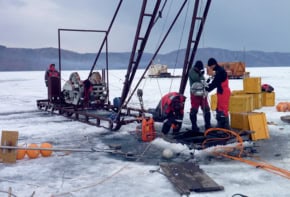
Two key US federal funding agencies – the Department of Energy’s Office of High Energy Physics and the National Science Foundation’s Physics Division – have revealed the three “second generation” direct-detection dark-matter experiments that they will support. The agencies’ programme will include the Super Cryogenic Dark Matter Search-SNOLAB (SuperCDMS), the LUX-ZEPLIN (LZ) experiment and the next iteration of the Axion Dark Matter eXperiment (ADMX-Gen2).
“We are pleased to announce that the joint DOE/NSF second-generation programme will include the LZ and SuperCDMS-SNOLAB experiments with their collective sensitivity to both low- and high-mass WIMPS, and ADMX-Gen2 to search for axions. It will also include a programme of R&D to test and develop technologies for future experiments, consistent with the recent P5 recommendations,” says a joint statement from the two agencies. The P5 recommendations refer to the Particle Physics Project Prioritization Panel’s (P5) 2014 report, which was released in May this year. The P5 advisory panel considered what high-energy particle-physics experiments and collaborations the US government should fund across the next five years, in the light of declining spending on particle physics in the US.
Narrowing the field
Programme directors at both the DOE and the NSF have been looking into which of the many dark-matter-detector design bids they have received would give the best results. After narrowing it down to five experiments last year, the final three were chosen based on the advice of an external panel of experts.
Second-generation dark-matter experiments are experiments that will reach sensitivities that are at least 10 times better than current detectors can achieve. The ADMX-Gen2 will hunt for a dark-matter candidate particle known as an axion.
Both the LZ and the SuperCDMS will look for a type of dark-matter particle called WIMPs – weakly interacting massive particles – across a range of masses. SuperCDMS, which will be underground at SNOLAB in Ontario, Canada, will be particularly good at looking for light WIMPs with masses lower than 10 GeV.
The LZ is the union of the UK-based ZEPLIN programme, which has run three experiments at the Boulby mine during the past decade, and the current most sensitive dark-matter detector – the US-based LUX experiment. Like most of today’s dark-matter experiments, LUX is currently nestled deep in a subterranean cavern at the Sanford Underground Research Facility in South Dakota in the US, to shield it from any background sources – if all goes to plan, LZ will occupy the same space in a few years.
Unprecedented sensitivity
“While the SuperCDMS is wonderful at low masses, the LZ has unprecedented sensitivity across the scale,” says Chamkaur Ghag, from University College London, who was involved in ZEPLIN and now works on both LUX and LZ, and is delighted by the news of the US backing. “None of the competing experiments will be able to match it at that timescale,” he says.
Ghag told physicsworld.com that dark-matter searches must sweep from heavy to light particles because the masses of WIMPs are currently unknown. The technology developed for the current LUX detector was initially pioneered in the UK, “so it is wonderful to see the progress it has now made”, he says. Ghag explains that the UK also carried out a similar consolidation process last year, and the LZ detector was once more chosen to be the project of choice. He points out that the added US backing will further boost the already advanced design of LZ, saying that there is major UK involvement in the project. Three out of 10 main “work packages” that include building the cryostat that will hold the experiment, developing the internal “eyes” of the detectors or its photomultiplier tubes and screening all of the materials that will be used in constructing the detector, will be co-lead by researchers in the UK, who will also work on other parts of the project.
“This announcement by the US funding agencies DOE and NSF means that the LZ dark-matter experiment is on its way to becoming an approved project in the US. In the UK we are about to submit a proposal to the Science and Technology Facilities Council (STFC) for a three-year construction programme,” says Henrique Araujo, from Imperial College London, who is the principal investigator for LZ in the UK. “LZ uses extremely sensitive liquid-xenon detector technology to search for the very rare and extremely faint interactions of dark-matter particles – that we believe make up most of the mass of the universe.” With all three detectors gearing up to being up and running in the next few years, it could be only a matter of time before the dark-matter debate will be settled once and for all.



